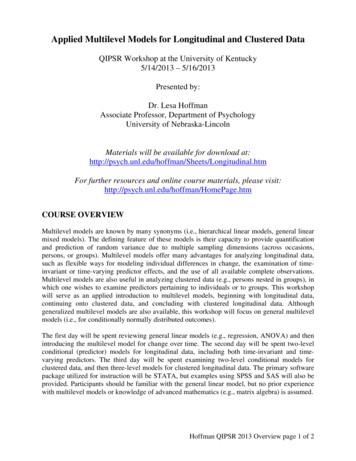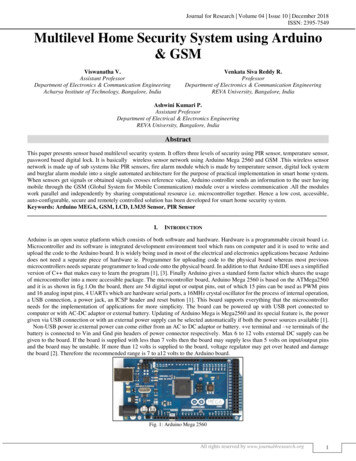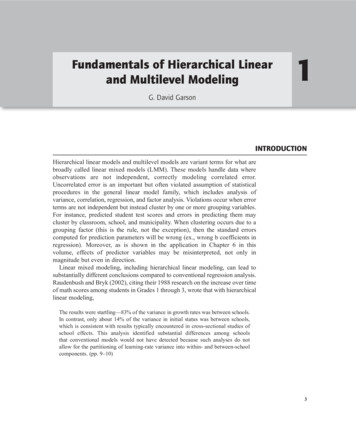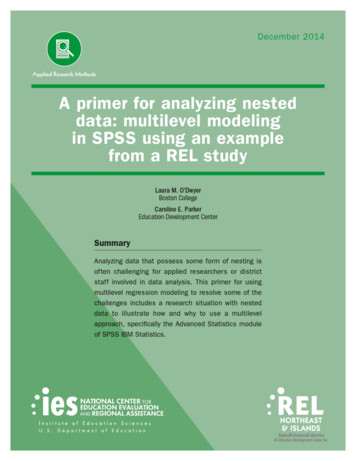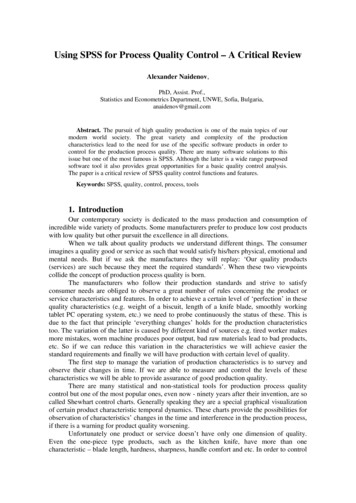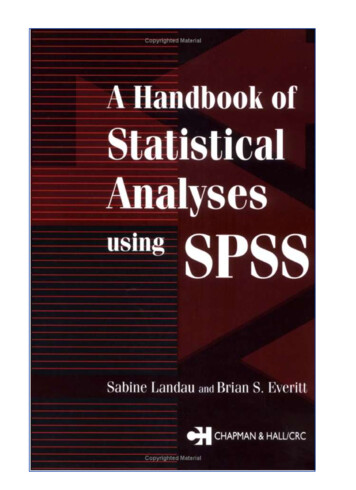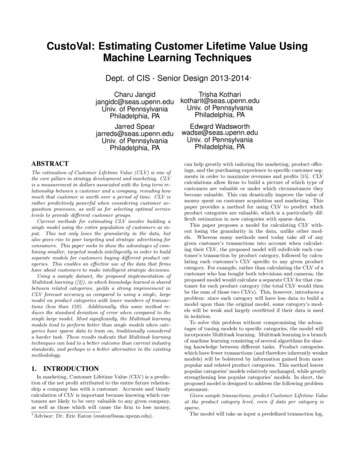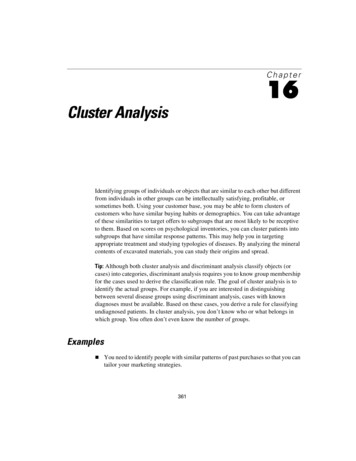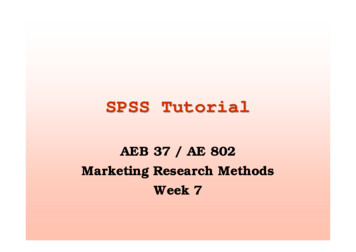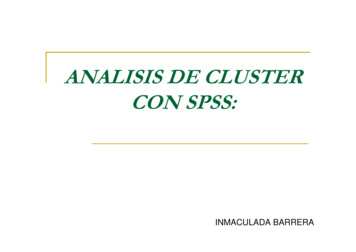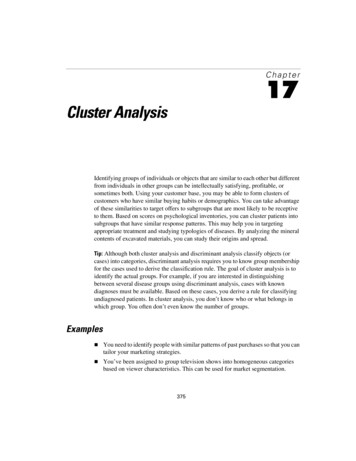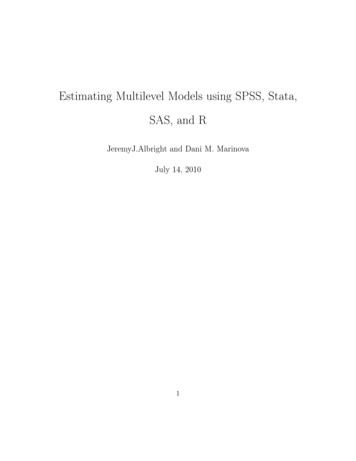
Transcription
Estimating Multilevel Models using SPSS, Stata,SAS, and RJeremyJ.Albright and Dani M. MarinovaJuly 14, 20101
Multilevel data are pervasive in the social sciences.1Students may be nestedwithin schools, voters within districts, or workers within rms, to name a few examples. Statistical methods that explicitly take into account hierarchically structureddata have gained popularity in recent years, and there now exist several specialpurpose statistical programs designed speci cally for estimating multilevel models(e.g. HLM, MLwiN). In addition, the increasing use of of multilevel models alsoknown as hierarchical linear and mixed e ects models has led general purposepackages such as SPSS, Stata, SAS, and R to introduce their own procedures forhandling nested data.Nonetheless, researchers may face two challenges when attempting to determinethe appropriate syntax for estimating multilevel/mixed models with general purposesoftware.First, many users from the social sciences come to multilevel modelingwith a background in regression models, whereas much of the software documentation utilizes examples from experimental disciplines [due to the fact that multilevelmodeling methodology evolved out of ANOVA methods for analyzing experimentswith random e ects (Searle, Casella, and McCulloch, 1992)]. Second, notation formultilevel models is often inconsistent across disciplines (Ferron 1997).The purpose of this document is to demonstrate how to estimate multilevel modelsusing SPSS, Stata SAS, and R. It rst seeks to clarify the vocabulary of multilevelmodels by de ning what is meant by xed e ects, random e ects, and variancecomponents. It then compares the model building notation frequently employed inapplications from the social sciences with the more general matrix notation found1 Jeremywrote the original document. Dani wrote the section on R and rewrote parts of thesection on Stata.2
in much of the software documentation.The syntax for centering variables andestimating multilevel models is then presented for each package.1Vocabulary of Mixed and Multilevel ModelsModels for multilevel data have developed out of methods for analyzing experi-ments with random e ects. Thus it is important for those interested in using hierarchical linear models to have a minimal understanding of the language experimentalresearchers use to di erentiate between e ects considered to be random or xed.In an ideal experiment, the researcher is interested in whether or not the presenceor absence of one factor a ects scores on an outcome variable.2Does a particularpill reduce cholesterol more than a placebo? Can behavioral modi cation reduce aparticular phobia better than psychoanalysis or no treatment? The factors in theseexperiments are said to be xed because the same, xed levels would be included inreplications of the study (Maxwell and Delaney, pg. 469). That is, the researcher isonly interested in the exact categories of the factor that appear in the experiment.The typical model for a one-factor experiment is:yij µ αj eijwhere the score on the dependent variable for individual2 In(1)i is equal to the grand meanthe parlance of experiments, a factor is a categorical variable. The term covariate refers tocontinuous independent variables.3
of the sample (µ), the e ecteij .α of receiving treatment j , and an individual error termIn general, some kind of constraint is placed on the alpha values, such that theysum to zero and the model is identi ed. In addition, it is assumed that the errorsare independent and normally distributed with constant variance.In some experiments, however, a particular factor may not be xed and perfectlyreplicable across experiments. Instead, the distinct categories present in the experiment represent a random sample from a larger population. For example, di erentnurses may administer an experimental drug to subjects.Usually the e ect of aspeci c nurse is not of theoretical interest, but the researcher will want to control forthe possibility that an independent caregiver e ect is present beyond the xed druge ect being investigated. In such cases the researcher may add a term to control forthe random e ect:yij µ αj βk (αβ)jk eijwhereβrepresents the e ect of the(2)k th level of the random e ect, and αβrepresentsthe interaction between the random and xed e ects. A model that contains onlyxed e ects and no random e ects, such as equation 1, is known as amodel.xed e ectsOne that includes only random e ects and no xed e ects is termed ae ects model.Equation 2 is actually an example of amixed e ects modelrandombecause itcontains both random and xed e ects.While the notation in equation 2 for the random e ect is the same as for thexed e ect (that is, both are denoted by subscripted Greek letters), an importantdi erence exists in the tests for the drug and nurse factors. For the xed e ect, the4
researcher is interested in only those levels included in the experiment, and the nullhypothesis is that there are no di erences in the means of each treatment group:H0 : µ1 µ2 . µjH1 : µj 6 µj 0For the random e ect in the drug example, the researcher is not interested in theparticular nurses per se but instead wishes to generalize about the potential e ectsof drawing di erent nurses from the larger population. The null hypothesis for therandom e ect is therefore that its variance is equal to zero:H0 : σβ2 0H1 : σβ2 0The estimated variance is known as avariance component, and its estimation is anessential step in mixed e ects models.Oftentimes in experimental settings, the random e ects are nuisances that necessitate statistical controls. In the above example, the e ect of the drug was theprimary interest, whereas the nurse factor was potentially confounding but theoretically uninteresting. It is nonetheless necessary to include the relevant random e ectsin the model or otherwise run the risk of making false inferences about the xede ect (and any xed/random e ect interaction). In other applications, particularlyfor the types of multi-level models discussed below, the random e ects are of substantive interest. A researcher comparing test scores of students across schools may5
be interested in a school e ect, even if it is only possible to sample a limited numberof districts.The reason to review random e ects in the context of experiments is that methodsfor handling multilevel data are actually special cases of mixed e ects models. Hoxand Kreft (1994) make the connection clearly: An e ect in ANOVA is said to be xed when inferences are to be madeonly about the treatments actually included. An e ect is random whenthe treatment groups are sampled from a population of treatment groupsand inferences are to be made to the population of which these treatmentsare a sample. Random e ects need random e ects ANOVA models (Hays1973). Multilevel models assume a hierarchically structured population,with random sampling of both groups and individuals within groups.Consequently, multilevel analysis models must incorporate random effects (pgs. 285-286).For scholars coming from non-experimental disciplines (i.e.those that rely moreheavily on regression models than analysis of variance), it may be di cult to makesense of the documentation for statistical applications capable of estimating mixedmodels.Political scientists and sociologists, for example, come to utilize mixedmodels because they recognize that hierarchically structured data violate standardlinear regression assumptions.However, because mixed models developed out ofmethods for evaluating experiments, much of the documentation for packages likeSPSS, Stata, SAS and R is based on examples from experimental research. Henceit is important to recognize the connection between random e ects ANOVA and6
hierarchical linear models.Note that the motivation for utilizing mixed models for multilevel data does notrest on the di erent number of observations at each level, as any model including adummy variable involves nesting (e.g. survey respondents are nested within gender).The justi cation instead lies in the fact that the errors within each randomly sampledlevel-2 unit are likely correlated, necessitating the estimation of a random e ectsmodel. Once the researcher has accounted for error non-independence it is possibleto make more accurate inferences about the xed e ects of interest.2Notation for Mixed and Multilevel ModelsEven if one is comfortable distinguishing between xed and random e ects, addi-tional confusion may emerge when trying to make sense of the notation used to describe multilevel models. In non-experimental disciplines, researchers tend to use thenotation of Raudenbush and Bryk (2002) that explicitly models the nested structureof the data.Unfortunately his approach can be rather messy, and software docu-mentation typically relies on matrix notation instead. Both approaches are detailedin this section.In the archetypical cross-sectional example, a researcher is interested in predictingtest performance as a function of student-level and school-level characteristics. Usingthe model-building notation, an empty (i.e. lacking predictors) student-level model7
is speci ed rst:Yij β0j rijThe outcome variableoutcome in unitjYfor individuali(3)jnested in schoolplus an individual-level errorrij .is equal to the averageBecause there may also be ane ect that is common to all students within the same school, it is necessary to adda school-level error term.This is done by specifying a separate equation for theintercept:β0j γ00 u0jwhere(4)γ00 is the average outcome for the population and u0jis a school-speci c e ect.Combining equations 3 and 4 yields:Yij γ00 u0j rijDenoting the variance ofrijasσ2and the variance of(5)u0jasτoo ,the percentageof observed variation in the dependent variable attributable to school-level characteristics is found by dividingτ00by the total variance:ρ Hereρis referred to as theτ00τ00 σ 2intraclass correlation coe cient.(6)The percentage ofvariance attributable to student-level traits is easily found according toA researcher who has found a signi cant variance component forτ001 ρ.may wish toincorporate macro level variables in an attempt to account for some of this variation.8
For example, the average socioeconomic status of students in a district may impactthe expected test performance of a school, or average test performance may di erbetween private and public institutions. These possibilities can be modeled by addingthe school-level variables to the intercept equation,β0j γ00 γ01 (MEANSESj ) γ02 (SECTORj ) u0j(7)and substituting 7 into equation 3. MEANSES stands for the average socioeconomicstatus while SECTOR is the school sector (private or public).Additionally, the researcher may wish to include student-level covariates. A student's personal socioeconomic status may a ect his or her test performance independent of the school's average socioeconomic (SES) score. Thus equation 3 wouldbecome:Yij β0j β1j (SESij ) rij(8)If the researcher wishes to treat student SES as a random e ect (that is, theresearcher feels the e ect of a student's SES status varies between schools), he cando so by specifying an equation for the slope in the same manner as was previouslydone with the intercept equation:β1j γ10 u1j(9)Finally, it is possible that the e ect of a level-1 variable changes across scores ona level-2 variable. The e ect of a student's SES status may be less important in aprivate rather than a public school, or a student's individual SES status may be more9
important in schools with higher average SES scores. To test these possibilities, onecan add the MEANSES and SECTOR variables to equation 9.β1j γ10 γ11 (MEANSESj ) γ12 (SECTORj ) u1j(10)A random-intercept and random-slope model including level-2 covariates andcross-level interactions is obtained by substituting equations 7 and 10 into 8:Yij γ00 γ01 (MEANSESj ) γ02 (SECTORj ) γ10 (SESij ) γ11 (MEANSESj SESij ) γ12 (SECTORj SESij )(11) u0j u1j (SESij ) rijThis approach of building a multilevel model through the speci cation and combination of di erent level-1 and level-2 models makes clear the nested structure ofthe data. However, it is long and messy, and what is more, it is inconsistent withthe notation used in much of the documentation for general statistical packages. Instead of the step-by-step approach taken above, the pithier, and more general, matrixnotation is often used:y Xβ Zu Hereyis annx 1 vector of responses,e ects regressors,βis aXis ann(12)xpmatrix containing the xedp x 1 vector of xed-e ects parameters,of random e ects regressors,uis aqZis anx 1 vector of random e ects, andnxq matrixis annx 1vector of errors. The relationship between equations 11 and 12 is clearest when, in10
the step-by-step approach, the xed e ects are grouped together in the rst part ofthe right-hand-side of the equation and the random e ects are grouped together inthe second part.Yij γ00 γ01 (MEANSESj ) γ02 (SECTORj ) γ10 (SESij ){z} Fixed E ects γ11 (MEANSESj SESij ) γ12 (SECTORj SESij ) {z}(13)Fixed E ects u0j u1j (SESij ) rij{z} Random E ectsNote that it is possible for a variable to appear as both a xed e ect and a randome ect (appearing in bothXandZfrom 12). In this example, estimating 13 wouldyield both xed e ect and random e ect estimates for the student-level SES variable.The xed e ect would refer to the overall expected e ect of a student's socioeconomicstatus on test scores; the random e ect gives information on whether or not this e ectdi ers between schools.3EstimationAn essential step to estimating multilevel models is the estimation of variancecomponents. Up until the 1970s, the literature on variance component estimationfocused on using ANOVA techniques that derived from the work of Fisher [adaptedto unbalanced data by Henderson (1953)].Since the 1970s, Full and RestrictedMaximum Likelihood estimation (FML and REML, respectively) have become the11
preferred methods. ML approaches have several advantages, including the ability tohandle unbalanced data without some of the pathologies of ANOVA methods (i.e.lack of uniqueness, negative variance estimates).Both FML and REML produceidentical xed e ects estimates. The latter, however, takes into account the degreesof freedom from the xed e ects and thus produces variance components estimatesthat are less biased. One downside to REML is that the likelihood ratio test cannotbe used to compare two models with di erent xed e ects speci cations. In smallsamples with balanced data, REML is generally preferable to ML because it is unbiased. In large samples, however, di erences between estimates are neglible (Snijdersand Bosker 1999). Thus, in most applications, the question of which method to useremains a matter of personal taste (StataCorp 2005, pg. 188).The remainder of this document provides syntax for estimating multilevel modelsusing SPSS, Stata, SAS, and R. The data analyzed will be the High School andBeyond (HSB) dataset that accompanies the HLM package (Raudenbush et al. 2005).Each section will show how to estimate the empty model, a random intercept model,and a random slope model from the student performance example outlined above.The dependent variable is scores on a math achievement scale. Note that whereasHLM requires two separate data les (one corresponding to each level), SPSS, Stata,SAS, and R rely on only a single le. The level-2 observations are common to eachcase within the same macro-unit, so that if there are 50 students in one school thecorresponding school-level score appears 50 times. Each program also requires an idvariable identifying the group membership of each individual. The results presentedbelow are based on REML estimation, the default in each package.12
4SPSSThis section closely follows Peugh and Enders (2005).It demonstrates how togroup-mean center level-1 covariates and estimate multilevel models using SPSS syntax.Note that it is also possible to use theAnalyzeMixed Modelsoption under thepull-down menu (see Norusis 2005, pgs. 197-246). However, length consid-erations limit the examples here to syntax. The SPSS syntax editor can be accessedby going toFile New Syntax.In the HSB data le, the student-level SES variable is in its original metric(a standardized scale with a mean of zero).Oftentimes researchers dealing withhierarchically structured data wish to center a level-1 variable around the meanof all cases within the same level-2 group in order to facilitate interpretation ofthe intercept.To group-mean center a variable in SPSS, rst use theAGGREGATEcommand to estimate mean SES scores by school. In this example, the syntax wouldbe:AGGREGATE OUTFILE sesmeans.sav/BREAK id/meanses MEAN(ses) .TheOUTFILEstatement speci es that the means are written out to the le ses-means.sav in the working directory.TheBREAKsubcommand speci es the groupswithin which to estimate means. The nal line names the variable containing theschool meansmeanses.Next, the group means are sorted and merged with the original data using theSORT CASESandMATCHFILEScommands. The centered variables are then created13
using theCOMPUTEcommand.3The syntax for these steps would be:SORT CASES BY id .MATCH FILES/TABLE sesmeans.sav/FILE */BY id .COMPUTE centses ses - meanses .EXECUTE .The subcommands fortheAGGREGATEMATCH FILESask SPSS to take the data le saved usingcommand and merge it with the working data (denoted by *). Thematching variable is the school ID.With the data prepared, the next step is to estimate the models of interest. Thefollowing syntax corresponds to the empty model (5):MIXED mathach/PRINT SOLUTION TESTCOV/FIXED INTERCEPT/RANDOM INTERCEPT SUBJECT(id) .The command for estimating multilevel models isby the dependent variable.PRINT SOLUTIONe ects estimates and standard errors.FIXED followed immediatelyrequests that SPSS report the xedandRANDOMtreat as xed and random e ects, respectively. Thevertical lineMIXED,specify which variables toSUBJECToption following theidenti es the grouping variable, in this case school ID.The xed and random e ect estimates for this and subsequent models are displayed in Table 1. The intercept in the empty model is equal to the overall averagemath achievement score, which for this sample is 12.637. The variance component3 Togrand mean center a variable in SPSS requires only a single line of syntax. For example,COMPUTE newvar oldvar - mean(oldvar).14
corresponding to the random intercept is 8.614; for the level-1 error it is 39.1483. Inthis example, the value of the Wald-Z statistic is 6.254, which is signi cant (p .001).Note, however, that these tests should not be taken as conclusive. Singer (1998, pg.351) writes, the validity of these tests has been called into question both because theyrely on large sample approximations (not useful with the small samplesizes often analyzed using multilevel models) and because variance components are known to have skewed (and bounded) sampling distributionsthat render normal approximations such as these questionable. A more thorough test would thus estimate a second model constraining the variancecomponent to equal zero and compare the two models using a likelihood ratio test.The two variance components can be used to partition the variance across levelsaccording to equation 6 above. The intraclass correlation coe cient for this exampleis equal to8.6148.614 39.1483 .1804,meaning that roughly 18% of the variance is at-tributable to school traits. Because the intraclass correlation coe cient shows a fairamount of variation across schools, model 2 adds two school-level variables. Thesevariables aresector,de ning whether a school is private or public, andmeanses,which is the average student socioeconomic status in the school. The SPSS syntaxto estimate this model is:MIXED mathach WITH meanses se
(e.g. HLM, MLwiN). In addition, the increasing use of of multilevel models also known as hierarchical linear and mixed e ects models has led general purpose pacageks such as SPSS, Stata, SAS, and R to introduce their own procedures for handling nested data. Nonetheless, researc
